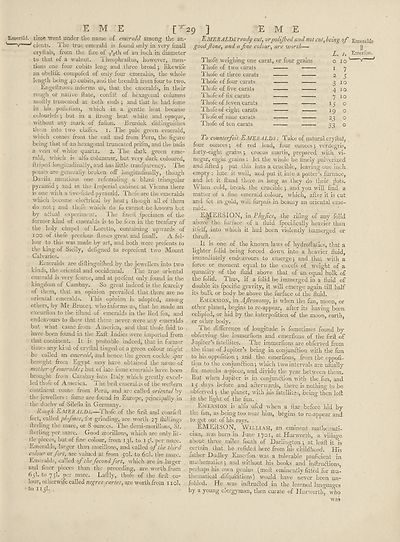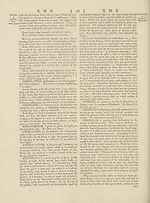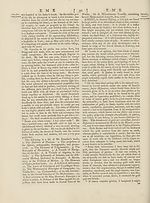Encyclopaedia Britannica, or, a Dictionary of arts, sciences, and miscellaneous literature : enlarged and improved. Illustrated with nearly six hundred engravings > Volume 8, ELE-FOR
(41) Page 29
Download files
Complete book:
Individual page:
Thumbnail gallery: Grid view | List view

E M E [ ~ 2 9
Emerald, time went under the name of emerald among the an-
cients. The true emerald is found only in very fmall
ciyllals, from the lize of x^th of an inch in diameter
to that of a walnut. Theophraitus, however, men¬
tions one four cubits long and three broad ; likewife
an obeliik compoled of only four emeralds, the whole
length being 40 cubits, and the breadth from four to two.
Engcltroom informs us, that the emeralds, in their
rough or native ilate, confiit of hexagonal columns
moitly truncated at both ends } and that he had lome
in his poileilion, which in a gentle heat became
colourlefs; but in a itrong heat white and opaque,
without any mark of fuiion. JBrunick diitinguiihes
them into two ciaifes. 1. The pale green emerald,
which comes from the call and from Peru, the ligure
being that of an hexagonal truncated prifm, and the bads
a vein of white quartz. 2. The dark green eme¬
rald, which is alfo columnar, but very dark coloured,
itriped longitudinally, and has little tranlparency. The
points are generally broken off longitudinally, though
JDa/ila mentions one refembling a blunt triangular
pyramid 5 and in the Imperial cabinet at Vienna there
is one with a iive-dded pyramid. Thefe are the emeralds
which become electrical by heat; though all of them
do not; and thole which do fo cannot be kno wn but
by actual experiment. The fried Ipecimen of the
former kind of emeralds is to be If en in the treafury of
the holy chapel of Loretto, containing upwards of
IOO of thefe precious dones great and fmall. A fel¬
low to this was made by art, and both were prefents to
the king of Sicily, defigned to reprefent two Mount
Calvaries.
Emeralds are didinguifhed by the jewellers into two
kinds, the oriental and occidental. The true oriental
emerald is very fcarce, and at prefent only found in the
kingdom of Cambay. So great indeed is the fcareiiy
of them, that an opinion prevailed that there are no
oriental emeralds. This opinion is adopted, among
others, by Mr Bruce; who informs us, that he made an
excurfion to the iiland of emeralds in the Red fea, and
endeavours to ihow that there never were any emeralds
but what came from America, and that thofe faid to
have been found in the Ealt Indies were imported from
that continent. It is probable indeed, that in former
times any ki d of cryftal tinged of a green colour might
be called an emerald,, and hence the green cockle /par
brought from Egypt may have obtained the name of
mother of emeralds; but of late fome emeralds have been
brought from Cambay into Italy which greatly excel¬
led thofe of America. The bed emeralds of the weilem
continent come from Peru, and are called oriental by
the jewellers : fome are found in Europe, principally in .
the duchy of Silelia in Germany.
Rough Emeralds.—Thofe of the fird and coarfed
fort, called p/afmes, lor grinding, are worth 27 ihikings
llerling the marc, or S ounces. The demi-morillons, 81.
fterling per marc. Good morillons, which are only lit¬
tle pieces, but of fine colour, from 13I. to 1 $1. per marc.
Emeralds, larger than morillons, and called of the third
colour or fort, are valued at from 50I. to 60I. the marc.
Emeralds, called of the fecond fort, which are in larger
and finer pieces than the preceding, are worth from
65I. to 75I. per marc. Ladly, thofe of the fird co¬
lour, other wife called negres cartes, axe worth from x 10I.
to 115I.
] E M E
EMERALDS ready cut, orpolijjjed and not cut, being of Emeralds
goodJlone, and a fne colour, are worth-—
Thofe weighing one carat, or four grains
Thofe of two carats
Thofe o± three carats
Thofe of four carats —
Thofe of five carats ——
Thofe of fix carats
Thofe of feven carats
Thofe of eight carats
Thofe of nine carats
Thofe of ten carats
3
4
7
*9
23
33
7
5
10
10
10
o
o
.0
G
To counterfeit EMERALDS: Take of natural crydai,
four ounces; ol red lead, four ounces; verdegris.
r 7 . o # *
iorty-eight grams 5 crocus rnartis, prepared with vi¬
negar, eight grains ; let the whole be finely pulverized
and fitted j put this into a crucible, leaving one inch
empty : lute it well, and put it into a potter’s furnace,
and let it Hand there as long as they do their jiots.
\v hen cold, break the crucible } and you will find a
matter of a fine emerald colour, which, after it is cut
and let in gold, will furpals in beauty an oriental eme¬
rald.
EMERSION, in Phyjics, the riling of any folid
above the furlace of a tiuid Ipecxfically heavier than
itfelf, into which it had been violently immerged or
thrud.
It is one of the known laws of hydrodatics, that a
lighter folid being forced down into a heavier fluid,
immediately endeavours to emerge j and that with a
force or moment equal to the excefs of weight of a
quantity of the fluid above that of an equal bulk of
the folid. Thus, if a folid be immerged. in a fluid of
double its fpccific gravity, it will emerge again till half
its bulk or body be above the furface of the fluid.
Emersion, in Afronomy, is when the fun, moon, or
other planet, begins to re-appear, after its having been
eclipfed, or hid by the interpofition of the moon, earth,
or other body.
The difference of longitude is fometimes found by
obferving the immerfions and emerfions of the fird of
Jupiter’s iatellites. The immerfions are obferved from
the time of Jupiter’s being in conjunction with the fun
to his oppofition 5 arid the emerfions, from the oppofi-
tion to the conjunction 5 which two intervals are ufually
fix months a-piece, and divide the year between them.
But when Jupiter is in conjunction with the fun, and
15 days before and afterwards, there is nothing to be
obferved 5 the planet, with his fatellites, being then loft
in the light of the fun.
Emersion is alfu ufed when a ifar before hid by
the fun, as being too near him, begins to re-appear and
to get out of his rays.
EMERSON, William, an eminent mathemati¬
cian, was born in June 1701, at Hurworth, a village
aoout three miles fouth of Darlington ; at leaf! it is
certain that he refided here from his childhood. .His
rather Dudley E me Ton was a tolerable proficient in
mathematics j and without his books and mftruclions
perhaps his own genius (moft eminently fitted for ma¬
thematical difquilitions) would have never been un¬
folded. He was mdructed in the learned languages
by a young clergyman, then curate of Hurworth, who
was
Emerald, time went under the name of emerald among the an-
cients. The true emerald is found only in very fmall
ciyllals, from the lize of x^th of an inch in diameter
to that of a walnut. Theophraitus, however, men¬
tions one four cubits long and three broad ; likewife
an obeliik compoled of only four emeralds, the whole
length being 40 cubits, and the breadth from four to two.
Engcltroom informs us, that the emeralds, in their
rough or native ilate, confiit of hexagonal columns
moitly truncated at both ends } and that he had lome
in his poileilion, which in a gentle heat became
colourlefs; but in a itrong heat white and opaque,
without any mark of fuiion. JBrunick diitinguiihes
them into two ciaifes. 1. The pale green emerald,
which comes from the call and from Peru, the ligure
being that of an hexagonal truncated prifm, and the bads
a vein of white quartz. 2. The dark green eme¬
rald, which is alfo columnar, but very dark coloured,
itriped longitudinally, and has little tranlparency. The
points are generally broken off longitudinally, though
JDa/ila mentions one refembling a blunt triangular
pyramid 5 and in the Imperial cabinet at Vienna there
is one with a iive-dded pyramid. Thefe are the emeralds
which become electrical by heat; though all of them
do not; and thole which do fo cannot be kno wn but
by actual experiment. The fried Ipecimen of the
former kind of emeralds is to be If en in the treafury of
the holy chapel of Loretto, containing upwards of
IOO of thefe precious dones great and fmall. A fel¬
low to this was made by art, and both were prefents to
the king of Sicily, defigned to reprefent two Mount
Calvaries.
Emeralds are didinguifhed by the jewellers into two
kinds, the oriental and occidental. The true oriental
emerald is very fcarce, and at prefent only found in the
kingdom of Cambay. So great indeed is the fcareiiy
of them, that an opinion prevailed that there are no
oriental emeralds. This opinion is adopted, among
others, by Mr Bruce; who informs us, that he made an
excurfion to the iiland of emeralds in the Red fea, and
endeavours to ihow that there never were any emeralds
but what came from America, and that thofe faid to
have been found in the Ealt Indies were imported from
that continent. It is probable indeed, that in former
times any ki d of cryftal tinged of a green colour might
be called an emerald,, and hence the green cockle /par
brought from Egypt may have obtained the name of
mother of emeralds; but of late fome emeralds have been
brought from Cambay into Italy which greatly excel¬
led thofe of America. The bed emeralds of the weilem
continent come from Peru, and are called oriental by
the jewellers : fome are found in Europe, principally in .
the duchy of Silelia in Germany.
Rough Emeralds.—Thofe of the fird and coarfed
fort, called p/afmes, lor grinding, are worth 27 ihikings
llerling the marc, or S ounces. The demi-morillons, 81.
fterling per marc. Good morillons, which are only lit¬
tle pieces, but of fine colour, from 13I. to 1 $1. per marc.
Emeralds, larger than morillons, and called of the third
colour or fort, are valued at from 50I. to 60I. the marc.
Emeralds, called of the fecond fort, which are in larger
and finer pieces than the preceding, are worth from
65I. to 75I. per marc. Ladly, thofe of the fird co¬
lour, other wife called negres cartes, axe worth from x 10I.
to 115I.
] E M E
EMERALDS ready cut, orpolijjjed and not cut, being of Emeralds
goodJlone, and a fne colour, are worth-—
Thofe weighing one carat, or four grains
Thofe of two carats
Thofe o± three carats
Thofe of four carats —
Thofe of five carats ——
Thofe of fix carats
Thofe of feven carats
Thofe of eight carats
Thofe of nine carats
Thofe of ten carats
3
4
7
*9
23
33
7
5
10
10
10
o
o
.0
G
To counterfeit EMERALDS: Take of natural crydai,
four ounces; ol red lead, four ounces; verdegris.
r 7 . o # *
iorty-eight grams 5 crocus rnartis, prepared with vi¬
negar, eight grains ; let the whole be finely pulverized
and fitted j put this into a crucible, leaving one inch
empty : lute it well, and put it into a potter’s furnace,
and let it Hand there as long as they do their jiots.
\v hen cold, break the crucible } and you will find a
matter of a fine emerald colour, which, after it is cut
and let in gold, will furpals in beauty an oriental eme¬
rald.
EMERSION, in Phyjics, the riling of any folid
above the furlace of a tiuid Ipecxfically heavier than
itfelf, into which it had been violently immerged or
thrud.
It is one of the known laws of hydrodatics, that a
lighter folid being forced down into a heavier fluid,
immediately endeavours to emerge j and that with a
force or moment equal to the excefs of weight of a
quantity of the fluid above that of an equal bulk of
the folid. Thus, if a folid be immerged. in a fluid of
double its fpccific gravity, it will emerge again till half
its bulk or body be above the furface of the fluid.
Emersion, in Afronomy, is when the fun, moon, or
other planet, begins to re-appear, after its having been
eclipfed, or hid by the interpofition of the moon, earth,
or other body.
The difference of longitude is fometimes found by
obferving the immerfions and emerfions of the fird of
Jupiter’s iatellites. The immerfions are obferved from
the time of Jupiter’s being in conjunction with the fun
to his oppofition 5 arid the emerfions, from the oppofi-
tion to the conjunction 5 which two intervals are ufually
fix months a-piece, and divide the year between them.
But when Jupiter is in conjunction with the fun, and
15 days before and afterwards, there is nothing to be
obferved 5 the planet, with his fatellites, being then loft
in the light of the fun.
Emersion is alfu ufed when a ifar before hid by
the fun, as being too near him, begins to re-appear and
to get out of his rays.
EMERSON, William, an eminent mathemati¬
cian, was born in June 1701, at Hurworth, a village
aoout three miles fouth of Darlington ; at leaf! it is
certain that he refided here from his childhood. .His
rather Dudley E me Ton was a tolerable proficient in
mathematics j and without his books and mftruclions
perhaps his own genius (moft eminently fitted for ma¬
thematical difquilitions) would have never been un¬
folded. He was mdructed in the learned languages
by a young clergyman, then curate of Hurworth, who
was
Set display mode to:
![]() Universal Viewer |
Universal Viewer | ![]() Mirador |
Large image | Transcription
Mirador |
Large image | Transcription
Images and transcriptions on this page, including medium image downloads, may be used under the Creative Commons Attribution 4.0 International Licence unless otherwise stated. ![]()
| Permanent URL | https://digital.nls.uk/192263952 |
|---|
| Attribution and copyright: |
|
|---|
| Description | Ten editions of 'Encyclopaedia Britannica', issued from 1768-1903, in 231 volumes. Originally issued in 100 weekly parts (3 volumes) between 1768 and 1771 by publishers: Colin Macfarquhar and Andrew Bell (Edinburgh); editor: William Smellie: engraver: Andrew Bell. Expanded editions in the 19th century featured more volumes and contributions from leading experts in their fields. Managed and published in Edinburgh up to the 9th edition (25 volumes, from 1875-1889); the 10th edition (1902-1903) re-issued the 9th edition, with 11 supplementary volumes. |
|---|---|
| Additional NLS resources: |
|

